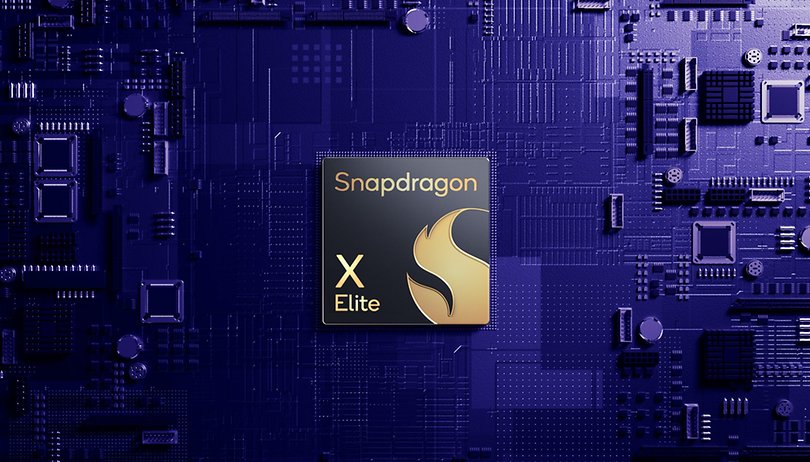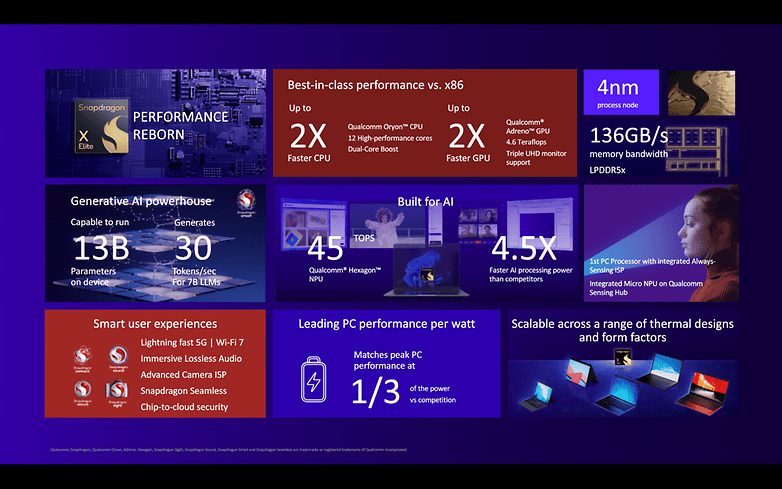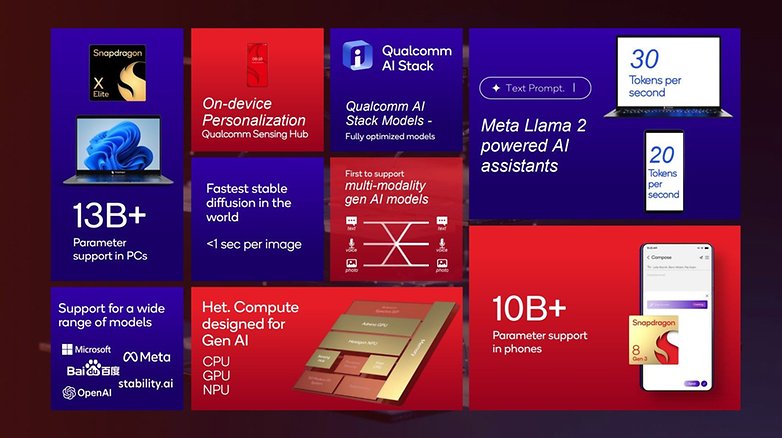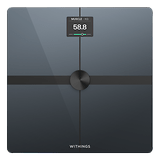Snapdragon X Elite Fires Up 12 ARM Cores to Take Over Windows


Read in other languages:
After teasing the name of its new PC processor, Qualcomm officially launched the Snapdragon X Elite chip on the Snapdragon Summit 2023. After years of Windows chips based on mobile designs, the X Elite brings 12 cores from the new Oryon custom ARM processor, promising “the most powerful, and efficient processor in its class for Windows.”
The Snapdragon X Elite is the result of a long series of business decisions at Qualcomm. After Apple took the computing world by storm with its transition to custom ARM chips on its PCs, all Qualcomm had to counter was its family of Snapdragon 8cx chips, which offered excellent connectivity and good battery life but only average performance—worsened by the fact at the time that most Windows apps were not optimized for ARM cores.
Qualcomm took the bold move of buying Nuvia in 2021, a startup founded in 2019 by former Apple (and Broadcom, and AMD, and Google) chip engineers, and rebranded its Phoenix ARM core to Oryon. And after many years of waiting, 2024 will see the first fruits of that purchase reaching retail products.
| Snapdragon X Elite | Snapdragon 8cx gen 3 | Apple M2 Max | Snapdragon 8 Gen 3 | Apple A17 Pro | |
|---|---|---|---|---|---|
| Prime core |
|
|
|
|
|
| Intermediate core |
|
|
|
|
|
| Efficiency core |
|
|
|
|
|
| RAM |
|
|
|
|
|
| GPU |
|
|
|
|
|
| Cellular modem |
|
|
|
|
|
| Connectivity |
|
|
|
|
|
| Process node |
|
|
|
|
|
The Snapdragon X Elite ditches the 4+4 combination of performance and efficiency cores from the 8cx family—which had lots of similarities with the flagship Snapdragon mobile chips—to pack 12 Oryon cores clocked at up to 3.8 GHz with a dual-core boost of up to 4.3 GHz, and no efficiency cores for low-priority tasks. Despite the high clocks, Qualcomm promises “multiple days of battery life”, thanks in part to the modern TSMC N4 process node.
Qualcomm displayed some relative graphs showing up to 2x performance at the same wattage or ⅓ power consumption at the same performance level when compared to an undisclosed rival x86 processor. While the Snapdragon X Elite topped at 50 W in the charts, the 14-core rival (presumably an Intel mobile chip, based on the core count) couldn’t match it even at a 90 W power draw.

The Snapdragon X Elite is also reportedly 50% faster in peak multithreaded performance than an (also undisclosed) ARM-based competitor. Since there is no rival in the Windows space, it is anyone's guess whether Qualcomm is drawing comparisons against rival mobile chips from MediaTek, Samsung, or Google, or if it is comparing itself with an Apple M chip.
Coincidence or not, Nvidia is rumored to be joining the Windows @ ARM ecosystem, according to Reuters, but as the Nuvia acquisition showed, it takes time to tailor custom ARM cores to a new market.

Regardless, the same bold claims apply to the integrated Adreno GPU, which offers DirectX 12 Ultimate support—and in turn includes ray tracing, variable refresh rate, and mesh shader support for the latest generation games. The Adreno core supports up to triple 4K (UHD), or dual 5K displays, and for the first time in Qualcomm’s PC chips, will offer upgradeable drivers, something that is rare on Android, but is traditional in the Windows ecosystem.
AI strikes again
As with any 2023 announcement, AI featured heavily in Qualcomm’s launch. But the Snapdragon X Elite claims of up to 4.5x AI performance versus the competition is easier to digest, since both AMD and Intel are just starting to add neural processing units (NPU) to their chips, while Qualcomm has been working for a long time on its Hexagon DSPs/NPUs.
The advertised 45 TOPS of overall AI performance is even higher than Apple’s 31.6 TOPS for the desktop M2 Ultra (or 15.8 on the mobile M2 Max), but it is important to note that AI numbers vary wildly according to the precision level used by the brands’ calculations.

As part of the AI block, Qualcomm is doubling down on its controversial (if not creepy) Sensing Hub, which relies on an always-sensing image signal processor (ISP) to provide customized experiences and security on compatible devices. Other parameters used by the hub include voice/audio, connectivity, and input from other sensors to, for example, ease logins or increase privacy.
On the connectivity front, the Snapdragon X Elite is powered by the FastConnect 7800 core, with support for Wi-Fi 7 and Bluetooth 5.4. Cellular connectivity is handled by the Snapdragon X65 5G modem, with (theoretical) downlink speeds of up to 10 Gbps. The X Elite also supports USB 4.0, SD cards compliant with the 3.0 spec, PCIe Gen 4 (including NVMe SSDs), and UFS 4.0 flash storage.
Qualcomm expects its partners to have PCs powered by the Snapdragon X Elite on the market by mid-2024.
Snapdragon Seamless
With a full suite of processors for the main types of personal computing devices—phones, watches, earbuds, VR/AR/MR, and PCs—, Qualcomm also announced an ecosystem initiative called Seamless to integrate the different experiences across your devices.
In partnership with Google, Microsoft, Asus, Dell, Honor, Lenovo, Oppo, Xiaomi, and other brands, Seamless promises to link multiple devices across Windows and Android, sharing data and accessories. The examples listed by Qualcomm mimic some of the features already available in Apple’s ecosystem, such as automatic audio switching between phone and PC, drag-and-dropping files, and even windows across different device types.

The announcement felt a little bit rushed, with few details about interoperability and security, and whether it will be available for devices on competing processors. Qualcomm announced that the first Seamless implementations will arrive already in 2023, but support for XR, vehicular platforms and AI will be coming “in the future”.
As with most Qualcomm announcements, real-world implementations will depend on its partners to come to market, but at least the Snapdragon X Elite carries a lot of promise with its new Oryon cores. Unfortunately, the company didn't announce any news regarding better x86 emulation performance or even ARM-native versions of mainstream apps like Chrome and its Widevine DRM. But there is still some time until the first Snapdragon X devices reach store shelves.



















